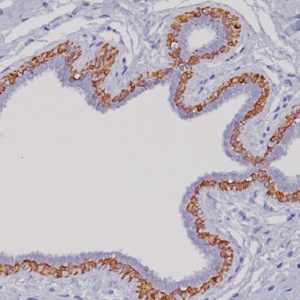Description
Clones EP17 and EP30 recognize cytokeratins (CK) 8 and 18, both of which are low molecular weight intermediate filament proteins (52.5 kDa and 45 kDa respectively). In normal tissues, CK8/18 recognizes all simple and glandular epithelium (1). In neoplastic tissues, CK8/18 may prove useful for the identification of most adenocarcinomas and some squamous cell carcinomas. CK8/18 expression patterns may also aid in the classification of tumors of unknown origin and poorly differentiated carcinomas (1-3). CK8/18 rabbit monoclonal may be useful as a staining mask in a multiplex stain with mouse monoclonal antibodies such as Ki-67, PD-1 or CD8. As CK8/18 does not stain stromal components or tumor infiltrating lymphocytes in various carcinomas such as breast or colon cancers, a CK8/18 staining mask may be helpful with these applications.
SPECIFICATIONS
Specifications
| FORMAT | Predilute |
|---|---|
| VOLUME | 6.0 ml |
| SOURCE | Rabbit Monoclonal |
| ISOTYPE | IgG |
| ANTIGEN | CK8/18 |
| LOCALIZATION | Cytoplasmic |
| POSITIVE CONTROL | Colon cancer |
DATASHEETS & SDS
REFERENCES
1. Moll R, Divo M, Langbein L. The human keratins: biology and pathology. Histochem Cell Biol. 2008 Jun;129(6):705-33.
2. Dabbs DJ. Diagnostic Immunohistochemistry. Philadelphia,PA: Churchill Livingstone, 2002.
3. Makino T, et al. Cytokeratins 18 and 8 are poor prognostic markers in patients with squamous cell carcinoma of the oesophagus. Br J Cancer. 2009 Oct 20;101(8):1298 -306.
4. Center for Disease Control Manual. Guide: Safety Management, NO. CDC-22, Atlanta, GA. April 30, 1976 “Decontamination of Laboratory Sink Drains to Remove Azide Salts.”
5. Clinical and Laboratory Standards Institute (CLSI). Protection of Laboratory Workers from Occupationally Acquired Infections; Approved Guideline-Fourth Edition CLSI document M29-A4 Wayne, PA 2014.







Reviews
There are no reviews yet.